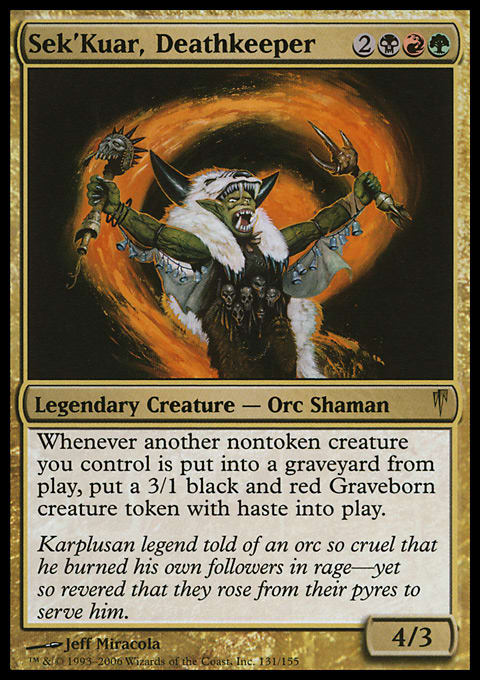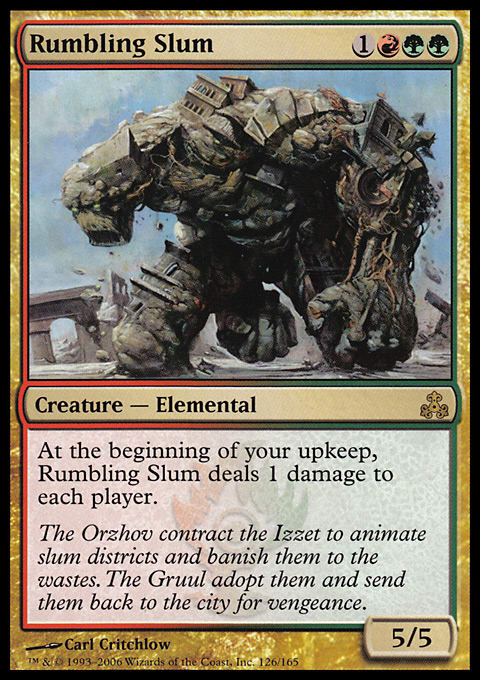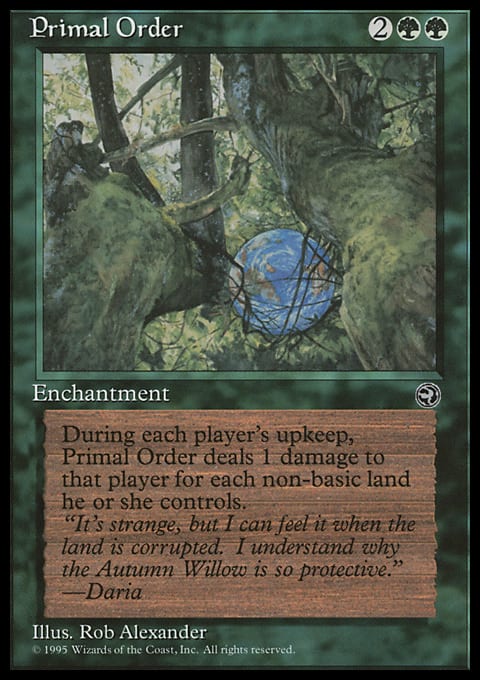Outgunned in the Multiverse
The metagame within my local Magic: the Gathering Commander group is evolving fast and I can’t keep up with it. It’s not just the strategies that are growing, it’s the money invested in the decks. I regularly find myself outgunned by an opponent’s Commander deck that I estimate is anywhere from $50 to $200 more valuable than mine. This value difference often means the opponent’s cards are faster and more powerful.
Have you ever found yourself in this situation? Ever find your decks outmatched simply because the others in your group are able to purchase the high-priced cards?
I’ve been in this situation many times. I don’t mind it so much anymore. I’m a casual Magic player with a family, a mortgage, and all the bills that come along with both. I’ve gone through seasons of spending fair amounts of money on Magic and also seasons in which I’ve missed entire blocks because I simply didn’t have the time or money to invest in the game. (I’m looking at you, Khans of Tarkir block.) And I’m certainly not going to be miffed because my friends can buy incredible cards. (Envious maybe, but not miffed.)
But what do you do when you’re in this situation? You love to play the game but you’re struggling to beat an opponent’s suped-up Commander deck.
Here’s one idea . . .
Disruption Eruption
I’ve started to think of certain cards as “disruptors.” These are cards that upset the status quo within a group. They’re typically:
- Surprising. They’re cards that don’t see a lot of play, sometimes because they have complicated phrasing (Simulacrum) and sometimes because they’re under-powered or expensive(Armageddon Clock).
- They affect board states that seem locked down.Possibility Storm is a great example. Unless someone has played Presence of the Master or some other enchantment hate, this card will make an impact in almost any Commander situation. Cyclone is another one. It doesn’t matter if your friend is piloting a modified Daxos the Returned deck with ten experience counters. All those enchantment tokens are going to take damage like everyone else.
- They’re likely to hurt you in some waytoo, or at least give your opponents an advantage. Concordant Crossroads is a great example, as is Rumbling Slum. You have to allow your opponents to share the advantage, or be willing to put yourself at a disadvantage to play with these cards. This is also part of what makes them surprising.
So there’s our working 3-part definition for disruptor cards in Commander: surprising, affects entire board states, and likely to hurt you too. Let’s take a look at deck built around disruptor cards.
Sek’Kuar, Deathkeeper The Disruptor
In a past article called, “When Magic Surprises You” I told the story about how Reins of Power got me excited to play Commander again. I was so inspired by the Commander 2016 Stalwart Unity deck that I decided to build a disruptor-based deck around Sek'Kuar, Deathkeeper. I chose this Commander simply because I had the most disruptor cards in his colors. I called the deck, “Everybody Hurts.”
(If you don’t know this song, then take a minute and follow that link. Listen to the song and have a good cry. It will put you in the right mood to crush your friends.)
Everybody Hurts ? Commander | Andy Rogers
- Commander (1)
- 1 Sek'Kuar, Deathkeeper
- Creatures (30)
- 1 Archetype of Aggression
- 1 Archetype of Endurance
- 1 Bloodgift Demon
- 1 Brooding Saurian
- 1 Butcher of Malakir
- 1 Dragonlair Spider
- 1 Drakestown Forgotten
- 1 Entrails Feaster
- 1 Humble Defector
- 1 Lord of Shatterskull Pass
- 1 Mitotic Slime
- 1 Mockery of Nature
- 1 Moldgraf Monstrosity
- 1 Necrotic Ooze
- 1 Pestilence Demon
- 1 Psychosis Crawler
- 1 Reaper from the Abyss
- 1 Rockslide Elemental
- 1 Rumbling Slum
- 1 Ruric Thar, the Unbowed
- 1 Servant of Tymaret
- 1 Steel Hellkite
- 1 Taurean Mauler
- 1 Terastodon
- 1 Thunderscape Battlemage
- 1 Thunderscape Familiar
- 1 Tornado Elemental
- 1 Verduran Emissary
- 1 Void Maw
- 1 Zhur-Taa Druid
- Instants (7)
- 1 Arcbond
- 1 Gruul Charm
- 1 Lightning Bolt
- 1 Naturalize
- 1 Rack and Ruin
- 1 Tribute to the Wild
- 1 Worldly Tutor
- Sorceries (8)
- 1 Decimate
- 1 Extinguish All Hope
- 1 Mass Mutiny
- 1 Molten Psyche
- 1 Savage Twister
- 1 Skyshroud Claim
- 1 Tempt with Vengeance
- 1 Traverse the Ulvenwald
- Enchantments (9)
- 1 Curse of Oblivion
- 1 Cyclone
- 1 Death Pits of Rath
- 1 Descent into Madness
- 1 Dictate of Karametra
- 1 Primal Order
- 1 Rites of Flourishing
- 1 Sulfuric Vortex
- 1 Sylvan Library
- Artifacts (11)
- 1 Armageddon Clock
- 1 Commander's Sphere
- 1 Elixir of Immortality
- 1 Howling Mine
- 1 Jinxed Choker
- 1 Jinxed Ring
- 1 Library of Leng
- 1 Lightning Greaves
- 1 Swiftfoot Boots
- 1 Tormod's Crypt
- 1 Whispersilk Cloak
- Lands (34)
- 3 Swamp
- 4 Mountain
- 5 Forest
- 1 Akoum Refuge
- 1 Bojuka Bog
- 1 Buried Ruin
- 1 Command Tower
- 1 Evolving Wilds
- 1 Ghost Quarter
- 1 Golgari Rot Farm
- 1 Gruul Guildgate
- 1 Jund Panorama
- 1 Jungle Hollow
- 1 Kazandu Refuge
- 1 Opal Palace
- 1 Reliquary Tower
- 1 Rogue's Passage
- 1 Rugged Highlands
- 1 Rupture Spire
- 1 Shimmering Grotto
- 1 Sulfurous Springs
- 1 Temple of Malice
- 1 Temple of the False God
- 1 Terramorphic Expanse
- 1 Transguild Promenade
I have a confession to make: the deck didn’t really work. I lost multiple games with it and never really felt like I was causing as much mayhem as I’d hoped to. The goal was to assemble a deck in which virtually every card affected every other player, and to play lots of disruptors, piling one on top of the other. In my imagination Sulfuric Vortex, Jinxed Choker, Jinxed Ring, Rumbling Slum, Cyclone, and Armageddon Clock were all in play at the same time while I tapped my Zhur-Taa Druid. Unfortunately, that just never came to pass.
Certain cards performed really well individually. Jinxed Choker was surprisingly effective, as was Rumbling Slum. And Taurean Mauler is always a problem for opponents.
But because I was losing many of the games I found myself holding onto cards like Descent into Madness rather than casting them. And Armageddon Clock was simply too slow for most games. By the time I got to six mana, I needed to cast removal, not one of my disruptors.
Also, I found that I rarely cast my Commander, Sek'Kuar, Deathkeeper. Though I picked him primarily because of his colors, I also thought that his ability would come into play more often. As my creatures died to my own disruptor cards, Sek’Kuar would be there to replace them with elemental tokens. Again, this never came to pass.
I ended up (re)learning a valuable MTG lesson:
I tweaked the deck list a few times, but ultimately deconstructed it. However, the goal of disrupting my local Commander meta-game remained strong, some would even say, unbowed . . .
To be Unbowed is to be Not Bowing (Duh)
“Unbowed” is a fantastic old word. In the bygone eras in which people actually bowed to one another out of chivalry or deference, this word was needed. What do we call it when someone in polite society doesn’t bow when they’re supposed to? We call them, unbowed.
Ruric Thar, the Unbowed and his Gruul friends evidently herald from this golden era of the English language, though Mr. Thar seems to make no apologies for breaking the rules of polite company. He’s an incredible disruptor card. It’s hard for anyone to take 6 damage just for casting a noncreature spell. Note that he deals out 6 damage when a card is cast, it doesn’t even need to resolve for Ruric to punish you.
So, in the spirit of the ill-fated Sek’Kuar “Everybody Hurts” deck, I arrived at the following:
Ruric?s Still Not Bowing ? Commander | Andy Rogers
- Commander (1)
- 1 Ruric Thar, the Unbowed
- Creatures (46)
- 1 Acidic Slime
- 1 Ambush Viper
- 1 Archetype of Aggression
- 1 Archetype of Endurance
- 1 Bloodbraid Elf
- 1 Bog-Strider Ash
- 1 Brooding Saurian
- 1 Brutalizer Exarch
- 1 Cinder Elemental
- 1 Clone Shell
- 1 Copperhorn Scout
- 1 Deadly Recluse
- 1 Dragonlair Spider
- 1 Elvish Mystic
- 1 Elvish Skysweeper
- 1 Falkenrath Marauders
- 1 Fertilid
- 1 Firefist Striker
- 1 Flamekin Harbinger
- 1 Forgotten Ancient
- 1 Hoard-Smelter Dragon
- 1 Ivy Lane Denizen
- 1 Kazuul, Tyrant of the Cliffs
- 1 Mad Prophet
- 1 Manic Vandal
- 1 Mardu Scout
- 1 Moldgraf Monstrosity
- 1 Mwonvuli Beast Tracker
- 1 Psychosis Crawler
- 1 Pyrewild Shaman
- 1 Rockslide Elemental
- 1 Rumbling Slum
- 1 Sakura-Tribe Elder
- 1 Skullwinder
- 1 Steel Hellkite
- 1 Stuffy Doll
- 1 Sylvan Ranger
- 1 Taurean Mauler
- 1 Terastodon
- 1 Torch Fiend
- 1 Tormentor Exarch
- 1 Tornado Elemental
- 1 Wickerbough Elder
- 1 Yavimaya Elder
- 1 Zhur-Taa Druid
- 1 Zhur-Taa Swine
- Spells (16)
- 1 Cyclone
- 1 Dictate of the Twin Gods
- 1 Fires of Yavimaya
- 1 Goblin War Drums
- 1 Possibility Storm
- 1 Primal Order
- 1 Sulfuric Vortex
- 1 Wild Evocation
- 1 Elixir of Immortality
- 1 Eternity Vessel
- 1 Grafted Exoskeleton
- 1 Jinxed Choker
- 1 Jinxed Ring
- 1 Swiftfoot Boots
- 1 Tormod's Crypt
- 1 Whispersilk Cloak
- Lands (36)
- 15 Mountain
- 16 Forest
- 1 Blighted Woodland
- 1 Evolving Wilds
- 1 Jund Panorama
- 1 Rogue's Passage
- 1 Terramorphic Expanse
A quick breakdown of the card choices goes like this:
Mana: In Commander decks I prefer to run between thirty and forty mana (often landing in middle at 35) along with a few mana rocks (artifacts) or mana creatures. Because this deck also runs Primal Order, I decided to put in a lot of mana-searching, or mana-producing creatures. As you can see, nonbasic lands have been avoided as much as possible. Rogue's Passage is a must for Ruric, since he attacks each turn if able. Terramorphic Expanse, Blighted Woodland, Jund Panorama, and Evolving Wilds won’t be around long enough to cause any damage.
Commander enhancing cards: I think most commander decks need at least twenty cards that are meant to enhance, complement, or otherwise enable their commander. Thirty or thirty-five cards are even better, if you can swing it. Cards like Swiftfoot Boots and Archetype of Endurance help turn Ruric into a major threat.
Grafted Exoskeleton on Ruric is devastating, especially if others at the table are running something with poison counters. Someone might be willing to take 6 poison counters to cast Naturalize on your Grafted Exoskeleton. However, if they know that the player next to them is running Inkmoth Nexus they may be more hesitant to do so.
Ruric with Grafted Exoskeleton and Dictate of the Twin Gods? That’s an instant kill.
Removal: Increasingly, I find that Commander decks function best when they have about 20 removal spells. This includes board wipes, counter spells, spot removal spells, Naturalize and Disenchant effects, as well as combat tricks that might act as removal, like Arcbond. I also put Fog effects in this grouping too because you can often bait an opponent by leaving yourself open while holding a Fog, allowing you to swing in for big damage on the next turn.
Because Ruric wants you to cast creatures, my removal spells are (for the most part) creature spells. Any additional “everybody hurts” disruptor cards are included in this section too since they are dealing direct damage.
Your Group’s Metagame: The last section of cards in a Commander list is about 5 to 10 cards. This small group of cards are specifically inserted to combat the unique metagame of your group. Many of these could be kept in your sideboard and substituted in as you have need.
In my group, lots of people run nonbasic lands, lots of people play Black, and lots of people run multiple enchantments and artifacts. So, cards like Rack and Ruin, Tranquility, Tectonic Edge, and anything with Swampwalk are a good bet. My group also plays a lot of decks that employ the graveyard as a resource. To combat this trend I find myself including Purify the Grave, Tormod's Crypt, Bojuka Bog, and Nihil Spellbomb in my decks more and more. I’ve even used Curse of Oblivion. None of these cards cost more than 50 cents. But if you have a couple of extra dollars, Grafdigger's Cage is nice too.
End Step
Give yourself a challenge — a dare. See if you can disrupt the metagame within your local Commander group in under $10. My Ruric list is a budget list. You could easily add more expensive creatures to it, but half the fun of disrupting a metagame is doing so with cards that most people have lying around. (Two other lists I like for this Commander can be found here and here.)
So, go to Coolstuffinc.com (he said, shamelessly promoting the Gathering Magic’s sponsor) and see what kind of disruptor cards you can find that will surprise and infuriate your friends. Bonus points to you if they are cards typically considered “unplayable.”
One of the things that makes Magic a great game is that you don’t have to spend big money in order to compete in most casual games. You just have to figure out create ways to break the metagame.
As I said previously, my group likes to play with lots of nonbasic lands in their Commander decks. I look forward to seeing how much damage I can do with a card from an “unplayable” set like Homelands. Primal Order meets our three-part definition for disruptor cards nicely: It’s surprising. It affects the whole board. And it might cause me a little damage too.
As Michael Stipe famously said, “Everybody hurts sometimes.”
























